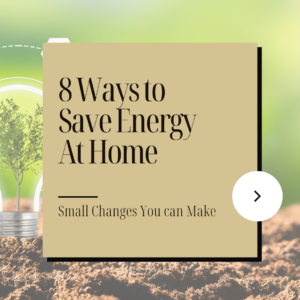In this 3-part mini series, Greening Your Home, you’ll learn ways to make your home more energy-efficient while also saving you money in the long run. This second article lists some simple ways you can save energy in your home.

Believe it or not, even small changes in your home can have an impact on your energy use (and your bills!). Many can be easy to implement and are inexpensive too.
Even though it’s recommended to have an energy audit by a professional, as discussed in last week’s article, Why Every Homeowner Should Do an Energy Audit , you don’t have to wait to save energy with some simple modifications. But remember that an audit will give you direction on some of the bigger energy issues with your home.
Here are some easy DIY fixes that you can do today or over a weekend to make your home more energy efficient.
1. Get a Programmable Thermostat.
If you don’t have one already than this is a must-do. It allows you to schedule your home’s temperature automatically depending on your daily routine – increasing when getting up, decreasing when you’re at work, increasing when you come home, and decreasing when you head to bed.
There are so many product selections out there with high-tech features such as motion sensors. You’ll save money heating and cooling your home at the right times for you and your family. And prices have come down so you should find one in your price range.
Some power providers will even provide the thermostat and install it for free! For example, you can check out Pepco’s program for DC and MD residents here. [Customize for any local programs]
2. Switch to a Smart Power Strip for Electronics.
It’s time to leave your old power strips in the dust, and look into a “smart” power strip. Who doesn’t see all the glowing lights from electronics when you turn off a room’s light. That’s energy being used for no good reason!
The traditional power strips probably have encouraged you to keep many of your electronics plugged in constantly, using power even when you’re not using them as they wait in standby mode. Smart strips will shut down power to products on standby mode and save you 5 to 10% of your energy consumption.
3. Install the Correct Lightbulbs for Your Needs.
With the use of incandescent bulbs a memory now, buying lightbulbs can be confusing! Before you go to the store (and pay for new bulbs), make sure you understand the differences between LEDs, CFLs, and Halogens so you don’t waste money on the wrong bulb.
The technology keeps changing and improving than the earlier ones so you might find one you like better now. Since these lightbulbs can last longer and are more expensive, make sure the manufacturer has a good refund or exchange program if something does go wrong.
4. Hang Laundry on Clothes Drying Rack.
Hanging clothes to dry may seem like you’re back in pioneer days but try it. Get in the habit of hanging some of your clothes on a foldable drying rack rather than in the dryer. Your clothes, your utility bill, and the environment will thank you!
This can help you cut down on the number of loads you put in the dryer each week – which translates to less electricity used.
If you have a patio or porch, you can put your rack outside for even quicker drying. (Or get a traditional clothesline to go old school.)
5. Install Ceiling Fans.
Some decorators hate the look of ceiling fans, but they actually can help your rooms stay cooler or warmer. There are more trendy and stylish designs to choose from now that could blend in with your rooms so don’t cross this off your list!
Fans can be a low-energy way to keep air circulating so you can keep your temperature set higher in the summer and lower in the winter.
Just remember to have the fans reversed in the winter so the air is pulled upwards and away from you.
6. Insulate Exposed Water Pipes.
Wrap your hot water pipes in the basement or garage with pipe insulation so they don’t lose heat as the water makes it way to your faucets. It can make a two-to-four-degree difference.
Check the pipes coming out of the hot water heater and insulate at least the first three feet.
7. Double Check Vents.
Walk around your home and make sure you’re not blocking your air vents with furniture or piles of stuff. You want this air flow to circulate efficiently to avoid having the heating and cooling blowing constantly. Also get them dust-free too.
8. Plant a Tree.
It sounds simple because it is. Having a shade tree can help cool your home during hot summers, especially if the sun is shining directly on your roof.
You’ll feel the difference since it can be 10% cooler in the shade. You and your home will be much happier since less AC will need to be cranking. And with less direct sunlight on your home, you’ll save energy costs.
Look into trees that work for your area and provide more opportunity for providing shade around your home.
Don’t forget about energy tax credits that many cities and states offer when you do any energy improvements. Let me know if you have any questions about these easy energy saving tips!
Hi there!
I'm Morgan and I love helping professionals in the aviation industry make their move to Atlanta as smooth as a greased landing. Whether its relocation, buying for the first time, or selling luxury and aviation real estate properties, I can help you transition smoothly.
Let's Meet
Contact
678-876-0865
CAVU Realty
15 Perry St. Suite 406
Newnan, GA 30263
morgan@theaviatoragent.com
Buy
my listings
Sell
All Articles
schedule your free consultation